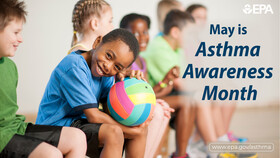May is Asthma Awareness Month

May is Asthma Awareness Month!
When you control your asthma, you can breathe easier, be active, and sleep well. The first step in raising asthma awareness is learning about asthma and educating friends, family, and others with ways to control asthma. Take action in your community by promoting asthma awareness and encouraging others to participate!
Learn more about Asthma Awareness Month:
Asthma Awareness
Asthma and Allergy Awareness
|
Asthma: Quick Facts
How common is asthma in Minnesota? About 1 in 24 children and 1 in 12 adults have asthma. Explore more information on asthma and asthma data:
Asthma in Minnesota
Asthma Data
Asthma in Minnesota: A Strategic Framework 2021-2030
Learn more by watching the video Understanding Air Quality and Your Health. A co-production of ECHO Minnesota and TPT, in Spanish, Hmong, Somali, and English.
"My Asthma Journey" with Catherine Diamond
The Asthma Program is featuring personal asthma stories highlighting people with asthma, families with children who have asthma, and others impacted by asthma. Asthma can be different for everyone, and symptoms and onset can vary from person to person. For questions about treatment and medical care, please consult a health care provider. MDH supports the 2020 Focused Updates to the Asthma Management Guidelines.
Meet Catherine:
Catherine works with the Minnesota Department of Health’s (MDH) Injury and Violence Prevention Section and leads Economics and Evaluation. She has been with MDH for over 5 years, initially as the Evaluator for the Asthma Program!
How would you describe your experiences with asthma?
While I’ve never had asthma myself, my daughters, Clara and Amelia, experience asthma symptoms. When Clara, my oldest daughter was 3, now 8 years old, she had a persistent cough that would wake her up at night. We had a lot of trouble finding a treatment plan and curing her cough as she couldn’t be diagnosed with asthma until she was older. With help from her primary care physician (PCP), Clara started using a quick relief inhaler and nebulizer at home to manage asthma symptoms, especially at night. My youngest daughter, Amelia, was diagnosed with croup, an infection that causes swelling in the lungs and problems breathing, experienced similar symptoms, but it quickly progressed to upper respiratory failure and was in the Minnesota Children's Hospital ICU for 6 days. After this episode Amelia also got her own quick relief inhaler and nebulizer. This has certainly been a journey with multiple trips to the Emergency Room, especially when my daughters had common colds, viral infections, and croup-like symptoms.
With help from a lot of doctors, we started to learn how to recognize signs and symptoms of asthma, control respiratory flare-ups, and be prepared to treat them at home. Clara has since been told she does not have diagnosed asthma. Amelia is still too young to be clinically diagnosed with asthma, but we have an Asthma Action Plan to know when to use maintenance and quick relief inhalers and nebulizers at home, and when it’s time to visit their PCP.
How did you learn about asthma management and finding asthma resources?
I was working directly in MDH’s Asthma Program as an Evaluator, but I didn’t know how to manage my daughters’ asthma. Through my colleagues, I started to find resources on asthma and proper inhaler technique to educate myself and my daughters and explain their asthma in a more simplified way. With education and a lot of practice, I learned that Clara and Amelia both developed asthma symptoms when they have upper respiratory infections. I now look for symptoms such as a runny nose or a distinct sounding cough that indicate it’s time to proactively start using a maintenance inhaler and quick relief as needed. I wasn't taught proper inhaler technique until after Amelia's emergency care. I am now comfortable with using an emergency line at the pulmonologist’s office to walk through steps for emergency care, rather than visiting a hospital. My daughters regularly visit their pulmonologist every 6 months to make sure their Asthma Action Plans are still working well.
What did you learn as a parent with children who have asthma?
When Clara started using an inhaler, no one taught me how to use it. There was no instruction from the pediatrician’s office or the pharmacy, and with no asthma experience, I didn’t know how to ensure they were inhaling the medicine correctly. I quickly learned that education is key and asking questions is extremely important, especially understanding that I have doctors I can consult. The group of doctors I used with Amelia and Clara gave me tools and resources and made me feel confident in my ability to handle this chronic challenge at home.
As a parent, my knowledge and confidence are so important in succeeding at home and making my daughters feel more comfortable and supported. They are more confident and aware of when it’s time to use their inhalers, or “puff” as they call it!
How can we build support and increase advocacy for people who have asthma in MN?
Education is so important. With Clara and Amelia, I was handed an inhaler and chamber without any demonstration or knowledge on what the devices were. Information from pediatrician offices and pharmacies can be lacking, and there is room for doctors, healthcare support roles, such as Nurse Practitioners and pharmacists, to take the time to provide more education to people with asthma and their families.
Education is the greatest opportunity to support people who have asthma and empower parents to be comfortable with providing care for their children.
Learn more about asthma and best asthma management practices.
If you would like to share your personal asthma story, we would love to hear from you! Please reach out to the Asthma Program: [email protected] | 651-201-5909
|
